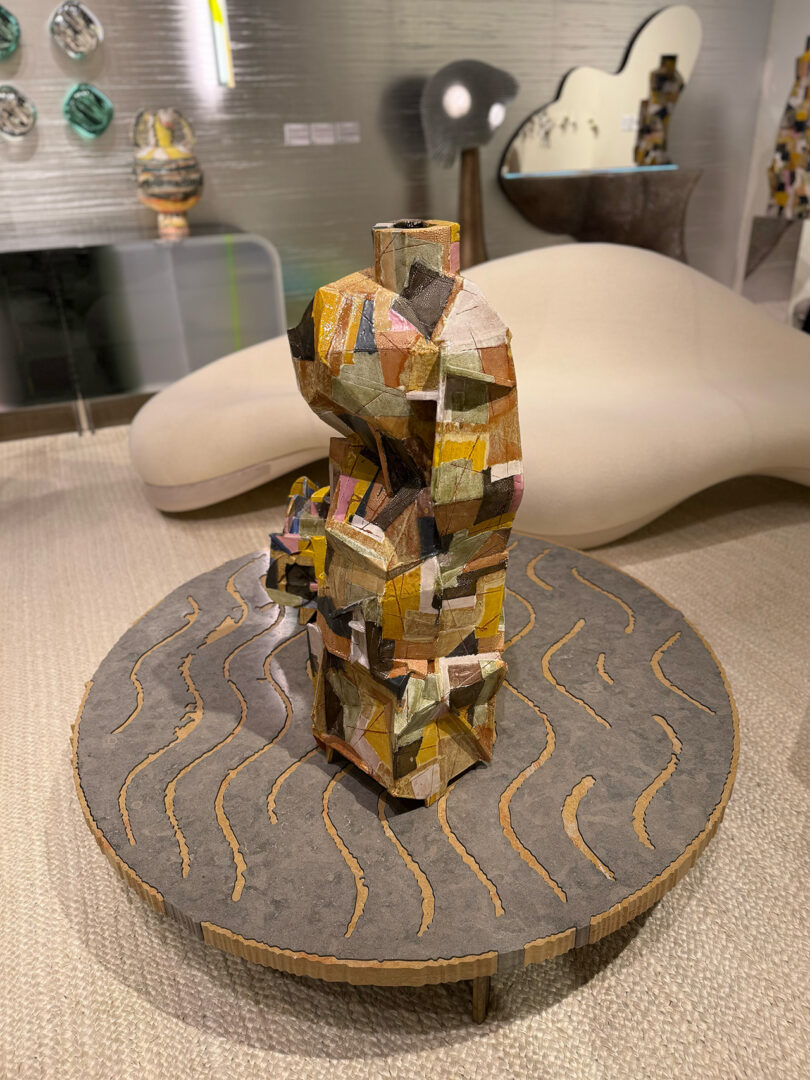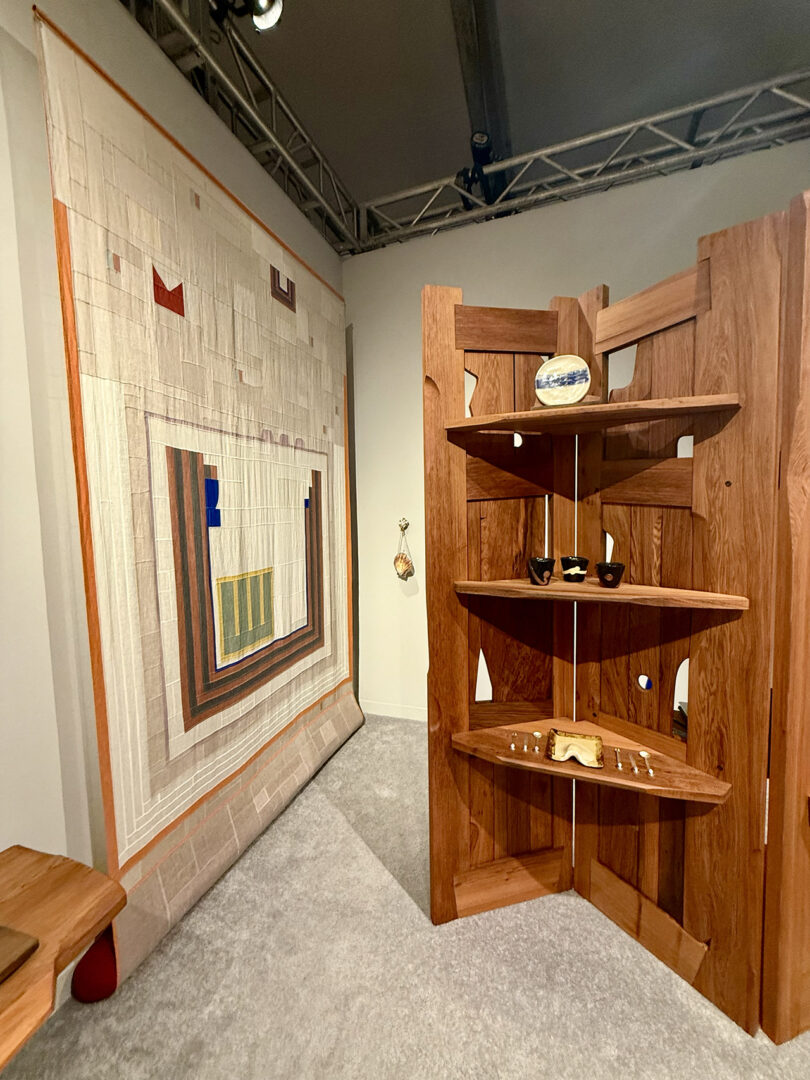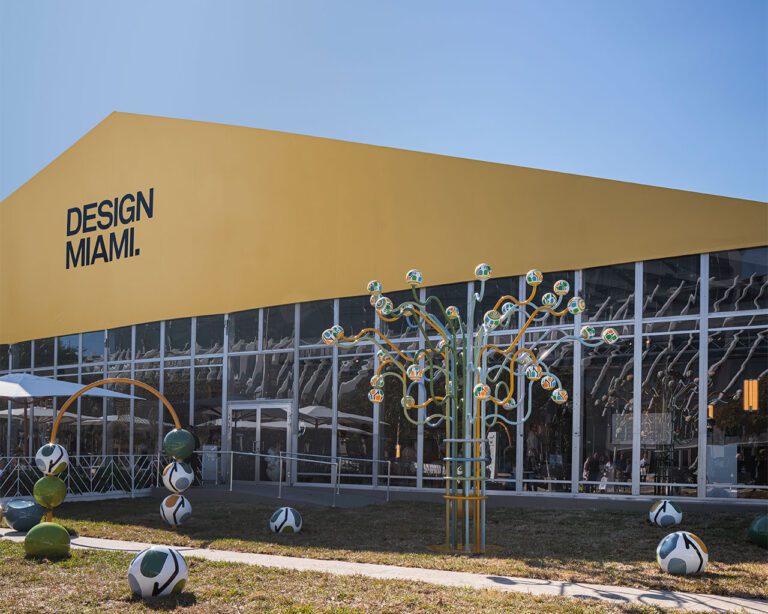Over the past two decades, the prominent Design Miami gallery has led the charge as a vital platform for the ever-evolving collectible design industry, an industry shaped from the antique furniture sector and to complement the fine art market. As many proponents have noted, beginning in the late 1990s, collectors began to understand the importance of not only displaying static paintings and sculptures in their homes but also complementing these spaces with functional and semi-functional furnishings that carry, in many cases, the same level of meaning and craft-driven experimentation.
In the early days, this branch of the ever-expanding design industry, much like the patronage model popular in Renaissance Florence, fostered wild, paradigm-shifting ideas: talent pushing the boundaries of materials and application. Although collectible design has veered closer to the world of aesthetically overly ornate, escapist and, at times, decorative arts, a handful of art galleries and cultural players have quickly caught on to the market’s original momentum.
Looking to shift the focus back to that mindset and redefine the term collectible design or what was once called artistic design as “avant-garde design” is historian, writer, culture maker and major proponent of the craft revival, Glenn Adamson. As artistic director of this year’s Design Miami fair, he implemented the concise but sweeping theme of “Blue Sky”—optimistic ideas that are not limited by current beliefs or societal norms. In many respects, Adamson was brought in to shape this edition from a ‘looking back to look forward’ perspective. A particularly strong showing this year shed new light on talent working in the industry who continues to challenge the boundaries of categorization, concept and self-expression.
Among the project’s 49 Curio galleries and displays, Design Milk has identified 10 highlights that embody this thinking in different ways.
Vespa floor lamp from Nader Jamas
Making his Design Miami debut with a custom Curio display, Dubai-based lighting and interior designer Nader Jammas unveils his Vessels collection – a botanical-inspired series of ceramic lamps that represents a marked departure from his penchant for brutalist forms. The Vespa Perpetual Lamp is a direct representation of the particularly curvy Metatrichia vesparium mushroom. The unique piece demonstrates how natural forms – not just those aesthetically rendered in a flat pattern – continue to inform the function of designed objects.


Shamar Studio Flap Chair, courtesy of Æquo Gallery
Æqou, which claims to be India’s first collectible design fair, was a huge hit at Design Miami for the second year in a row. His show was once again permeated by a strong sense of reinterpretation of the country’s richly diverse craft traditions and openness to cross-border collaboration, indicating what is in store for India’s rapidly emerging creative scene and its potential at an international level. Chamar Studio’s innovative Flap chair series was a standout. Produced entirely from rubber, these boldly colored sofas reflect the potential of this material’s properties to achieve their intended function.
According to the gallery: “Sudheer Rajbhar founded Chamar Studio in 2015 with the aim of reworking a term traditionally used as derogatory slang for the Dalit community working in the leather industry. When a beef ban threatened the livelihoods of leather workers, Sudheer innovatively introduced rubber as a sustainable alternative. The brand stands As an act of defiance, preserving the craft of the marginalized community and using her creativity as activism to highlight social injustice in India, the Flap Chair series is the latest iteration in a long series Of the designs that illustrate this exploration.


Double knot table by Nick Missel, courtesy of Wexler Gallery
Philadelphia-based designer Nick Maisel has shaped much of his practice around the idea of finding new purpose for traditional materials as a form of anthropological expression: translating the American working-class experience into particularly profound applications. Produced using fiberglass, resin and automotive paint, the REM Collection Double Knot Table is supplied by Wexler Gallery – resembling packing foam that has been frozen as durable, raised furniture.


The Sixth Cubist Yellow Ship by Christopher Russell, courtesy of Todd Merrill Studio
For over 30 years, New York-based talent Christopher Russell has been busy developing his painter-led ceramics practice through the lens of various creative disciplines. His latest geometrically composed vessels – defined by the spontaneous and systematic application of colorful patchwork – play on the tension between aesthetics and function. Ceramic vessels have been a necessity since the dawn of civilization. The eclectic yellow cubist ship—on view as part of Todd Merrill Studio’s equally radical show this year—perfectly demonstrates Russell’s iterative and formally experimental approach.


Silver chair designed by Luis Cimino for Fendi
Among a number of luxury brands creating creative and cultural projects that debuted at Design Miami, major Italian fashion house Fendi unveiled a capsule furniture collection by rising British designer Louis Cimino. The works align his deeply researched approach with the heritage producer’s unwavering commitment to artisanal tradition. The resulting backlit chairs, cabinets, coffee tables and wall pieces are meant to be both functional and subversive. The latter – as best illustrated in the Silver Chair – was accomplished in an almost discordant juxtaposition of wood and rough-hewn stone held together by polished metals with solid frames and inlaid into them.


Autonomous Mining by Jean Waterston, presented by Charles Burnand
London gallery Charles Burnand, an incomparable purveyor of furnishings and decorative elements that decisively push the boundaries of materials and modular application, is showcasing its Haptic Horizons collection at this year’s Design Miami. According to the gallery, the show “explored the future of materials, the progressive use of these elements, and the enduring importance of the artist’s hand in shaping our tangible world.” One of the most surprising pieces on display was the lounge chair by British talent Jan Waterston’s DIY Mining. A specially carved, almost rope-like design made of carved and stained ash wood. Through this piece, the designer explored the idea of excavation while blending ancient techniques with instinctive processes.


Tundra Freestanding Rack by Ryo Kobayashi, courtesy of Blunk Space
Blunk Space—the particularly active estate of revered California-based studio movement master J.B. Blunk—has housed Curio Gallery with commissioned and sourced works by contemporary talents responding to his creative and imaginative practice, perhaps best exemplified by his self-built home. Serving as a central anchor and even a display element for ceramics and smaller wares was a freestanding tundra rack by London-based designer Ryo Kobayashi. The piece was crafted using endemic redwood and is a direct reflection of the home’s distinctive architecture.


Robo lamp from Formafantasma, presented by Friedman Benda
Some in the know might say it’s a match made in heaven, and New York thought leader Friedman Benda has teamed up with leading research practice Formafantasma. Both entities share an understanding of the potential of design beyond form and function: a conduit for deeper historical, social and cultural meaning – and even provocation. Produced from cherry wood and LEDs, the Robo lamp looks clear and straightforward, but, unsurprisingly, it suggests much more. “The work explores the relationship between design, the domestic sphere, and the idea of an archetype… that embraces rigor and restraint,” explains Simone Varisen, co-founder of Formavantasma. The gallery is scheduled to host a solo show of new works by the Milan-based studio in spring 2025.


Time travel installation by Nuova Group
Fully immersive exhibition installations are rare at Design Miami, other than those installed by brand partners. It’s quite unusual to see this kind of comprehensive display at industry events in the United States. Changing things up this year is Los Angeles-based luxury design group Nuova Group, which has chosen to showcase the Curio as a reshaped interior from 1971 – a moment that, for many, was the last with a real sense of collective optimism for the future. . The “Time Travel” installation was intended to stimulate all the senses, and was designed without leaving any stone unturned. Everything from archival furnishings to candles and Andrea’s candelabra design — which, like the other furnishings, was imagined with a contemporary twist — was for sale to order.


Protea lamp designed by Jack Simmonds, courtesy of Objective Gallery
Shanghai and New York-based Objective Gallery chose to frame its booth display with the works of nine current talents defining the zeitgeist. The platform titled the show on a quote by David Hockney: “All art (design) is contemporary if it is alive” – a sentiment that refers to the increasingly stratified nature of the industry and the emergence of multiple simultaneous trends. Among the list of illustrious models was Brooklyn-based British designer Jack Simmonds, who often draws inspiration from vibrant forms and natural events. Framed in a semi-decomposed state, the Protea Lamp is a testament to this approach. The unique design combines natural dried protea flowers, burnt petals of the same flower, burnt bamboo, cast bronze and hand-carved marble as it solidifies as an otherworldly yet grounded light source. “What nature brings is fire and brilliance,” Simmonds describes.
To learn more about this annual exhibition and all its endeavors, visit designmiami.com.
Installation photography by Adrian Madlener.


